The topology view in the Red Hat OpenShiftConsole’s Developer’s Perspective provides a visual representation of the application structure. It helps developers to clearly identify one resource type from the other, as well as understand the overall communication dynamics within the application.
Launched with the 4.2 release of OpenShift, topology view has already earned a spotlight in the cloud-native application development arena. The constant feedback cycles and regular follow-ups on the ongoing trends in the developer community have helped in shaping a great experience in the upcoming release. This blog focuses on a few features in the topology view added for OpenShift 4.3.
1. Toggle between the list view and the graph view
In response to the user community, the topology view now comes with a toggle button to quickly switch between the list view and the graph view for a given project. While the graph view comes in very handy in use cases that require cognizance of the role played by individual components in the application architecture, list views could be helpful for more data-focused and investigative tasks. Introduction of this toggle would enable seamless navigation through views irrespective of the contrast in use-cases.
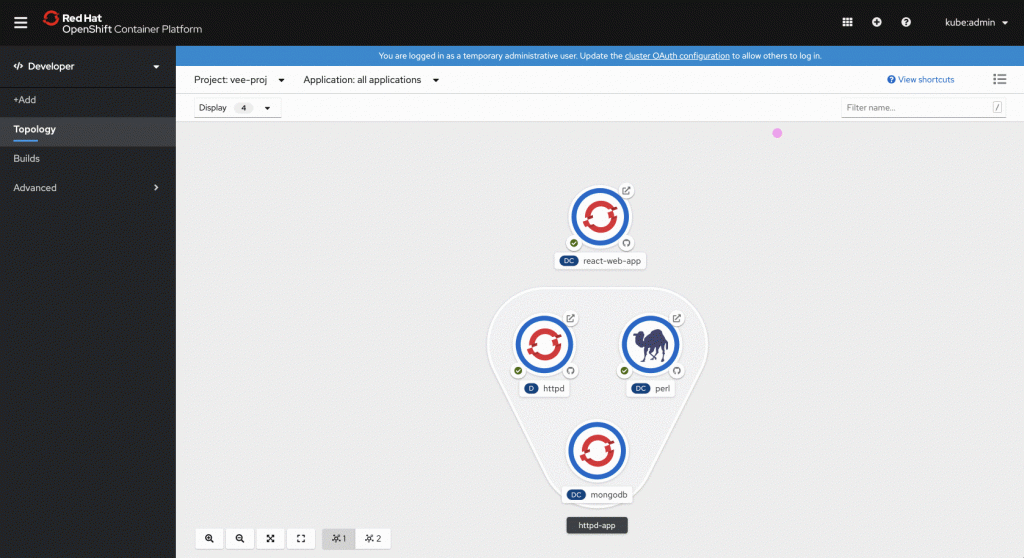
2. Menu for contextual actions
The topology view has a list of components available as a part of the graph. There are various kinds of resource types, connectors, groupings, individual items such as event sources, each one of which supports a different set of action in context. Users could access this exclusive menu for each of the listed items by performing a right-click over them, which further opens a dropdown list with all the available actions. Users could click anywhere outside the menu to make it disappear from the view.
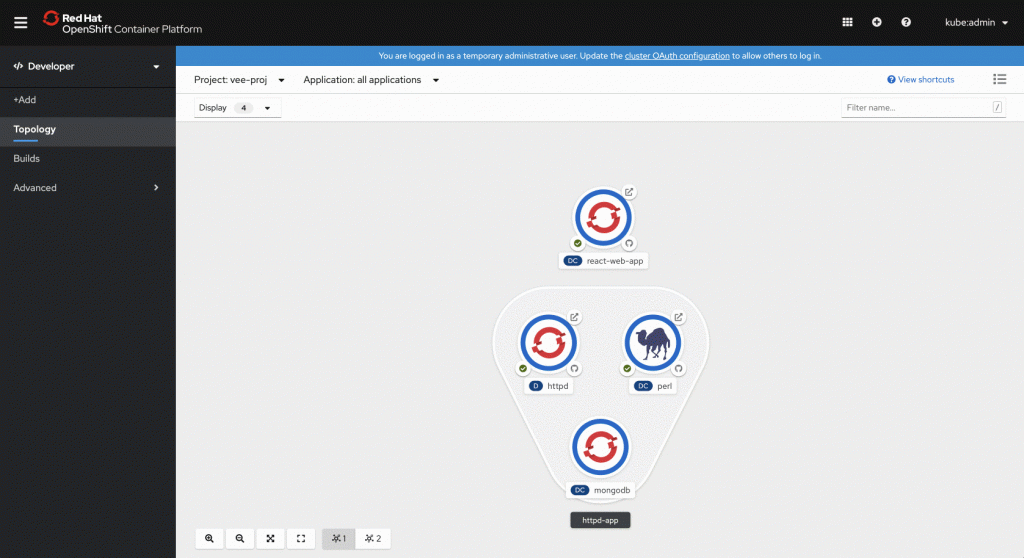
3. Creating a binding between resources
The topology view allows for creating a connection between any given pair of resources by simply dragging a handle from the origin nodes and dropping it over a target node. It reduces the cognitive load on the developer by doing a smart assessment of whether an operator-managed backing service is available for creating the intended binding. In the absence of an operator managed backing service, an annotation-based connection is created.
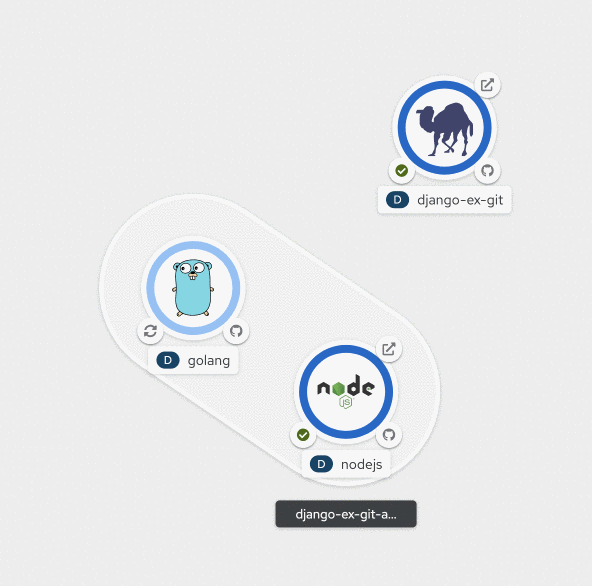
4. Real-time visualization of pod transition
The topology view in 4.3 provides convenient and upfront access to scale up/down and increase/decrease your pod count via the side panel. Similarly, users could also start rollout or recreate pods for a given node from the contextual menu(accessed through a right-click or from the actions button on the side panel). Upon performing the associated interaction from the side panel to accomplish any of the mentioned actions, users would get to see a real-time visualization of the transitions that the pods go through.
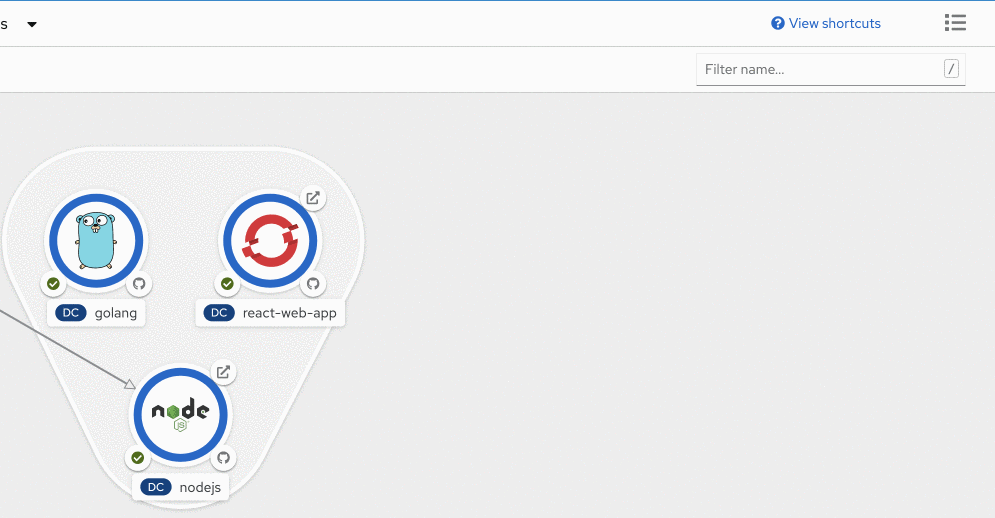
5. Deleting an applications
Topology view now supports deleting an application from the graph view. By invoking the contextual menu the given application grouping, either by performing a right-click or through the side panel, users could access the delete action. Upon confirming the action, the application group—comprised of components with the associated label, as defined by the Kubernetes-recommended labels—are deleted.
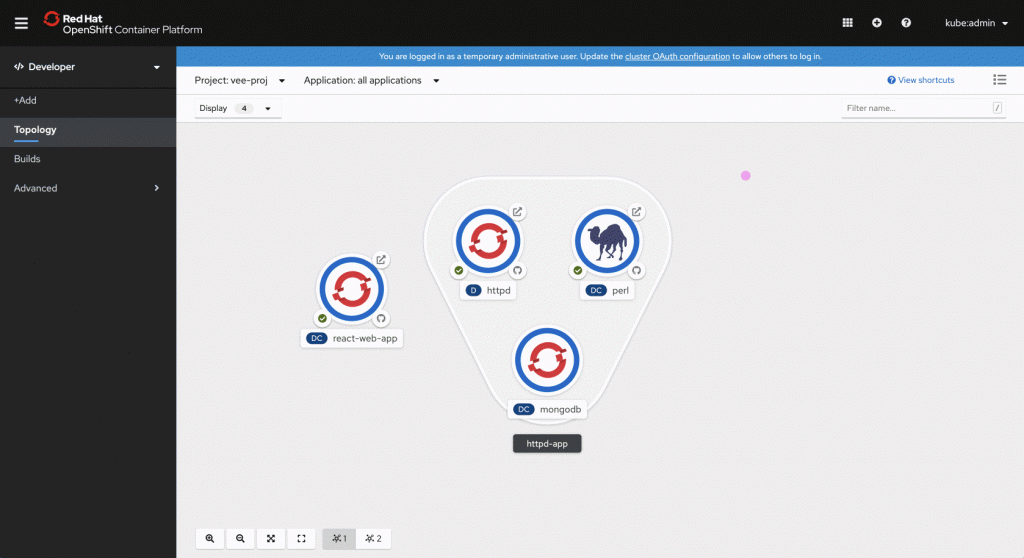
6. Visualization of Event Sources sink
The topology view shows elements from Knative Eventing, namely event sources, which help give a developer quick insight into which event sources will trigger their application by looking at it visually.

7. Viewing Knative Services and associated revisions
Users are now enabled to view Knative Service and the associated Revisions/Deployments in the topology view. The revisions in a service which are in the active traffic block would be displayed as a group on the topology view, along with the information on their traffic consumption.

With the continuous evolution of Kubernetes related technology and the introduction of new practices and integrations, OpenShift is constantly updated to reflect the progression.
Learn More
Interested in learning more about application development with OpenShift? Here are some resources which may be helpful:
- Red Hat resources on application development on OpenShift: developers.redhat.com/openshift
Provide Feedback
- Join our OpenShift Developer Experience Google Group, participate in discussions or attend our Office Hours Feedback session
- Drop us an email with your comments about the OpenShift Console user experience.
Über den Autor
Veethika Mishra is an Interaction Designer by practice and a tabletop gaming enthusiast. She believes in the power of play and storytelling in crafting extraordinary experiences. Her background in Game Design provides her with a fresh perspective for envisioning solutions for problems faced by developers. Her work at Red Hat focuses on providing developers the best of cloud-native application development experience and also allows her to observe and engage with the open communities from closer proximity. Besides designing for productivity and efficiency, she also values the role of fine typography and color interactions in enhancing the quality of overall user experience.
In her free time, she likes to write, learn to code, and design game concepts. She has also been long involved with the Creative Commons community and has been developing a process for designing educational games powered by CC licenses.
Nach Thema durchsuchen
Automatisierung
Das Neueste zum Thema IT-Automatisierung für Technologien, Teams und Umgebungen
Künstliche Intelligenz
Erfahren Sie das Neueste von den Plattformen, die es Kunden ermöglichen, KI-Workloads beliebig auszuführen
Open Hybrid Cloud
Erfahren Sie, wie wir eine flexiblere Zukunft mit Hybrid Clouds schaffen.
Sicherheit
Erfahren Sie, wie wir Risiken in verschiedenen Umgebungen und Technologien reduzieren
Edge Computing
Erfahren Sie das Neueste von den Plattformen, die die Operations am Edge vereinfachen
Infrastruktur
Erfahren Sie das Neueste von der weltweit führenden Linux-Plattform für Unternehmen
Anwendungen
Entdecken Sie unsere Lösungen für komplexe Herausforderungen bei Anwendungen
Original Shows
Interessantes von den Experten, die die Technologien in Unternehmen mitgestalten
Produkte
- Red Hat Enterprise Linux
- Red Hat OpenShift
- Red Hat Ansible Automation Platform
- Cloud-Services
- Alle Produkte anzeigen
Tools
- Training & Zertifizierung
- Eigenes Konto
- Kundensupport
- Für Entwickler
- Partner finden
- Red Hat Ecosystem Catalog
- Mehrwert von Red Hat berechnen
- Dokumentation
Testen, kaufen und verkaufen
Kommunizieren
Über Red Hat
Als weltweit größter Anbieter von Open-Source-Software-Lösungen für Unternehmen stellen wir Linux-, Cloud-, Container- und Kubernetes-Technologien bereit. Wir bieten robuste Lösungen, die es Unternehmen erleichtern, plattform- und umgebungsübergreifend zu arbeiten – vom Rechenzentrum bis zum Netzwerkrand.
Wählen Sie eine Sprache
Red Hat legal and privacy links
- Über Red Hat
- Jobs bei Red Hat
- Veranstaltungen
- Standorte
- Red Hat kontaktieren
- Red Hat Blog
- Diversität, Gleichberechtigung und Inklusion
- Cool Stuff Store
- Red Hat Summit

